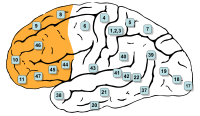
Photo from wikipedia
A lesion to the right hemisphere of the brain in humans commonly leads to perceptual neglect of the left side of the sensorium. The clinical observation that lesions to disparate… Click to show full abstract
A lesion to the right hemisphere of the brain in humans commonly leads to perceptual neglect of the left side of the sensorium. The clinical observation that lesions to disparate cortical and subcortical areas converge upon similar behavioural symptoms points to neglect as a dysconnection syndrome that may result from the disruption of a distributed network, rather than aberrant computations in any particular brain region. To test this hypothesis, we used Bayesian analysis of effective connectivity based on electroencephalographic recordings in ten patients (6 male, 4 female; age range 41-68) with left-sided neglect following a right-hemisphere lesion. In line with previous research, age-matched healthy controls showed a contralateral increase in connection strength between parietal and frontal cortex with respect to the laterality of audiospatial oddball stimuli. Neglect patients, however, showed a dysconnection between parietal and frontal cortex in the right hemisphere when oddballs appeared on their left side, but preserved connectivity in the left hemisphere when stimuli appeared on their right. This preserved fronto-parietal connectivity was associated with lower neglect severity. Moreover, we saw ipsilateral fronto-temporal connectivity increases for oddballs appearing on the neglected side, which might be a compensatory mechanism for residual left side awareness. No group differences were found in intrinsic (within-region) connectivity. While further validation is required in a bigger sample, our findings are in keeping with the idea that neglect results from the disruption of a distributed network, rather than a lesion to any single brain region. SIGNIFICANCE STATEMENT: Lesions to the right hemisphere of the brain commonly lead to neglect syndrome, characterized by perceptual deficits where patients are unaware of the left side of their body and environment. Using analysis of non-invasive electrophysiological recordings, we provide evidence that patients with left-sided neglect have reduced connectivity between the right parietal and frontal cortex during audiospatial stimuli, but preserved connectivity between regions in the non-lesioned left hemisphere. Moreover, for these intact connections we observed an ipsilateral fronto-temporal increase in connectivity during oddballs appearing on the neglected side, which might be a compensatory mechanism for residual perception. Crucially, we found that patients with more severe neglect symptoms had reduced connectivity between parietal and frontal cortex in the left hemisphere. This suggests that neglect may be caused by the disruption of a distributed network in the brain, rather than a lesion to any particular brain region.
Journal Title: Hearing Research
Year Published: 2021
Link to full text (if available)
Share on Social Media: Sign Up to like & get
recommendations!